Software Architecture Best Practices: What Works for Your Business?
When it comes to software architecture best practices, monolith and microservices are both valid choices. However, they are very different approaches, so there are ongoing debates over which of the two is smarter for software architecture and development. Some programmers say that only microservices can meet today’s demands, while others insist that monolith is still the most suitable and reliable choice.
In fact, both sides are right and wrong. At MadAppGang, we work equally on monolithic and microservices (including cloud-native) solutions. Based on our experience, we think both architecture practises work well, but in different situations. For example, it’s not possible to develop a cloud-native app using a monolithic structure. At the same time, it’s challenging to develop a very small app with microservices.
There’s also a lesser-known, third approach to software architecture and development, one that brings maximum value to your business regardless of the architecture type you choose. In this article we’ll review that third option and look at its advantages. But before that, let's cover monolith and microservices architecture in terms of software best practices and the pros and cons of each approach.
Monolithic architecture
Monolithic architecture is the most adopted approach for application development. Monolith apps typically consist of three tightly coupled layers: a client-side interface, a server-side application, and a database. This type of construction has one large codebase, meaning all app functions are managed and executed in one place. When you update or fix something, you have to make changes to the entire stack.
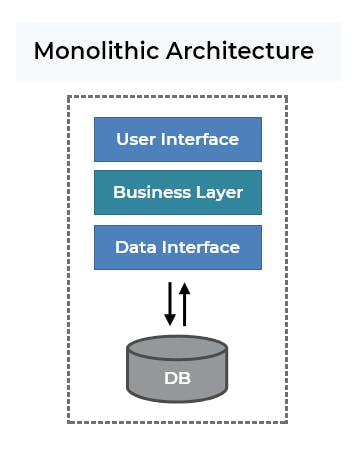
Source: Medium
Updating an entire app for a small change may seem like a major drawback. And it is, in some cases. However, like any solution, monolithic architecture has both advantages and disadvantages:
Key strengths
- Works well for small projects and doesn't require a huge budget.
- Easy development and faster deployment as there are numerous tools available for developers.
- Simple monitoring and end-to-end testing.
Main weaknesses
- It becomes difficult to read a large codebase when an app is scaled.
- Difficult to implement changes and updates as any change to the code affects the whole system.
- Challenging to scale the system because each element has its own resource requirements.
- Impossible to apply new technology without rewriting the entire application.
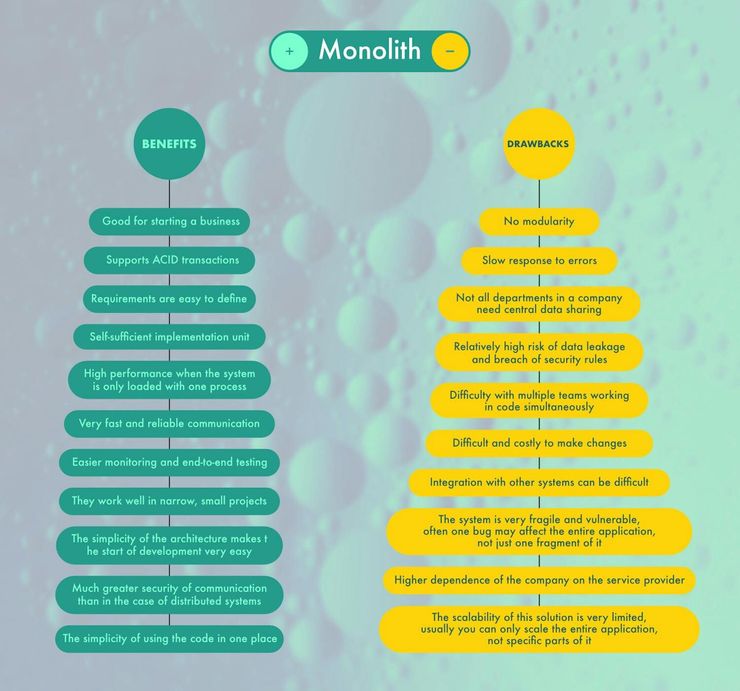
Source: Medium
Microservices
In an app built with a microservices architecture, small, independent services are implemented around a business domain and interlinked with application programming interfaces (APIs). Every service has its own logic and database, and each performs specific functions and can be updated, deployed, and scaled independently.
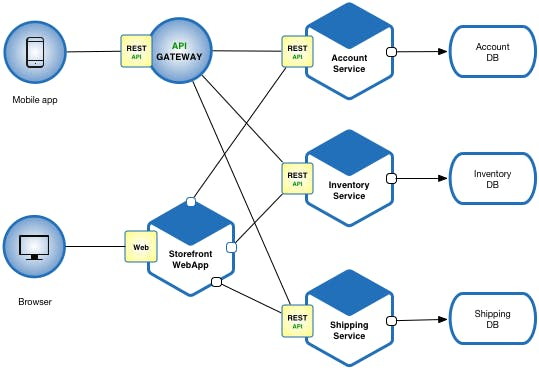
Microservices architecture. Source: Microservices.io
Key strengths
- High system stability. An error in one microservice doesn’t shut down or affect the entire application.
- Excellent performance, even in high-load systems.
- Several teams can work on an app simultaneously as it’s split into smaller components.
- Microservices architecture makes it faster and easier to scale an app, even to meet a dramatic difference in requirements, as each element can be scaled separately.
- Each individual microservice can be built using different technologies and frameworks.
- Easy to integrate new or external services through APIs.
Main weaknesses
- Microservices is a complex and distributed architecture, and it requires more expertise to set up an efficient inter-process communication mechanism.
- Each service has to be deployed independently. Establishing and maintaining coordination among multiple services can be time-consuming and requires more effort than deploying a web application archive (WAR) in a container.
- When developing a microservices system, you’ll face cross-cutting concerns such as health checks, logging, metrics, and externalised configuration.
- As microservices span more than one database by design, you'll need to synchronise data across databases. Often, this task is time-consuming and requires an extended budget.
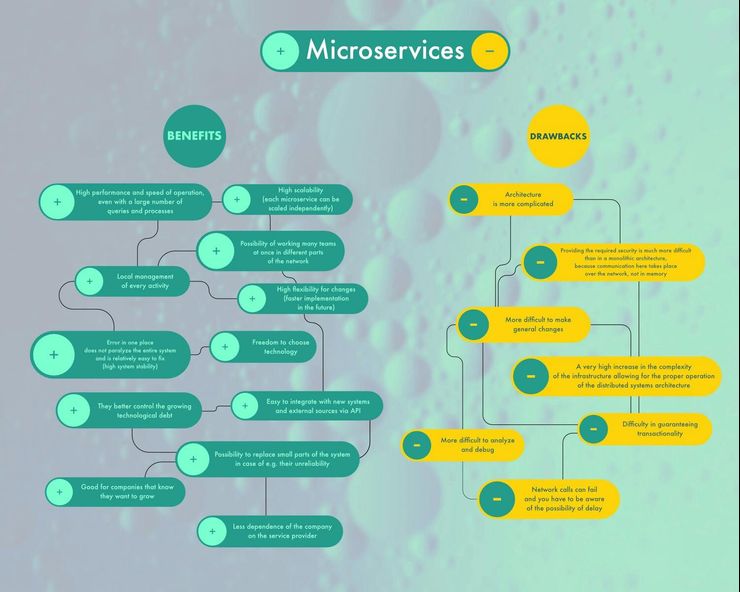
Source: Medium
Monolith vs microservices: Which approach fits your business?
In theory, monolithic and microservice architectures are equally good when comparing the pros and cons. Therefore, it's logical to make a choice based on the nature of your business. Monolithic construction makes more sense if you run a small business. Not only is it relatively cheaper and faster to build a monolith app, but it's also easier to manage it with a small team. Monolithic is also a suitable option to test the viability of ideas. It allows you to launch your software earlier while spending less money.
Microservices are a suitable fit for large-scale systems as they enable you to make changes and extend the product quickly and easily. If an individual microservice fails, it won't affect the entire app and, therefore, your customers. These advantages were convincing enough for leading companies such as Netflix, eBay, Gilt, Amazon, and others. By shifting from monolithic to microservices architecture, they reduced costs, achieved the highest level of scalability, and enhanced customer service.
It’s worth remembering, though, that both software architecture practices have drawbacks. With more complex systems, monolith generates more dependencies. The combination of code complexity and long deployment times not only makes scaling the solution difficult but it also takes a continuous integration/continuous delivery (CI/CD) strategy off the table. Microservices require a higher level of expertise for numerous reasons, for example, traditional monitoring methods will not work for microservice-based applications. Additionally, infrastructure layers must be configured to allow resource sharing between services. A poor configuration may increase latency or reduce the speed of calls.
Paving the third way
What if you realise that the software architecture best practices described above — monolithic and microservices — works perfectly for your project? It makes sense to search for a third option. A solution that maximises the merits while minimising the weaknesses of both practises — a domain-driven design (DDD).
DDD is an approach to software design that focuses on the creation of models with a deep understanding of the domain specific rules and processes. At MadAppGang, we often use this approach to bring maximum value for our customers and their projects.
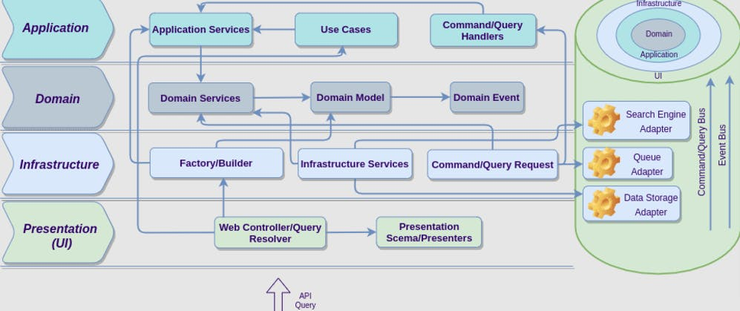
Schematic representation of DDD. Source: Dev.to
Simply put, DDD is based on the fact that any business can be divided into domains and multiple subdomains corresponding to different business tasks. Let's take an online shop as an example. Its subdomains might include the product catalogue, filtering system, user accounts, order management, and so on. Using DDD, you can choose the right approach and technology for each task, and focus on the business more than on the code itself. Apart from this, DDD has a lot of other advantages:
- Efficient communication – DDD involves the creation of a "ubiquitous language." Business and developers create a glossary of the business domain’s terms and concepts. It ensures that the "jobs-to-be-done" will be understood in the right way, without ambiguity.
- Easier to keep track and manage the project – The implementation of requirements becomes quite simple when everyone is using the same terminology.
- Better code and architecture – With DDD, every team understands the project’s business logic and is focused on the end product. The result is readable code with fewer duplications and a robust architecture.
- Flexibility – DDD is based on object-oriented design principles as nearly everything in the domain model is based on an object. The system components are modular and encapsulated, which allows for regular and continuous improvements.
- Easier testing – Since every feature’s functionality is strictly defined from the outset, it's easier to prepare tests.
Typically, DDD is associated with microservices since this approach perfectly matches DDD's concepts. But even if you’re planning to build a monolithic application, you can benefit from DDD's advantages. For instance, this approach helps to build software with a robust modular structure. Furthermore, you can migrate to microservices easier once you're ready to scale your company.
In a nutshell
The main criteria for choosing an app architecture is the nature and size of your business. On one hand, microservices is gaining in popularity, but this approach requires considerable expertise and investment; it’s unlikely to pay off for small projects. On the other hand, a monolith app can slow or even block the growth of your business.
In this situation, the DDD approach is the right solution as it works for businesses of any size. By using it, the development teams put a greater focus on the business tasks. In its turn, DDD helps build robust and clear structures, write comprehensive code, and establish solid communication. At MadAppGang, we have implemented DDD on a wide range of projects, both monolithic and microservices-based, and it always brings positive results.
Long story short, DDD saves time, money, and nerves. And if that's what you need, trust your project to MadAppGang. Not only will we use the most advanced technologies to build your app, but also modern approaches that mean you get a high-quality end product to the market fast. Contact us and let's find the right solution to bring your project to life.
